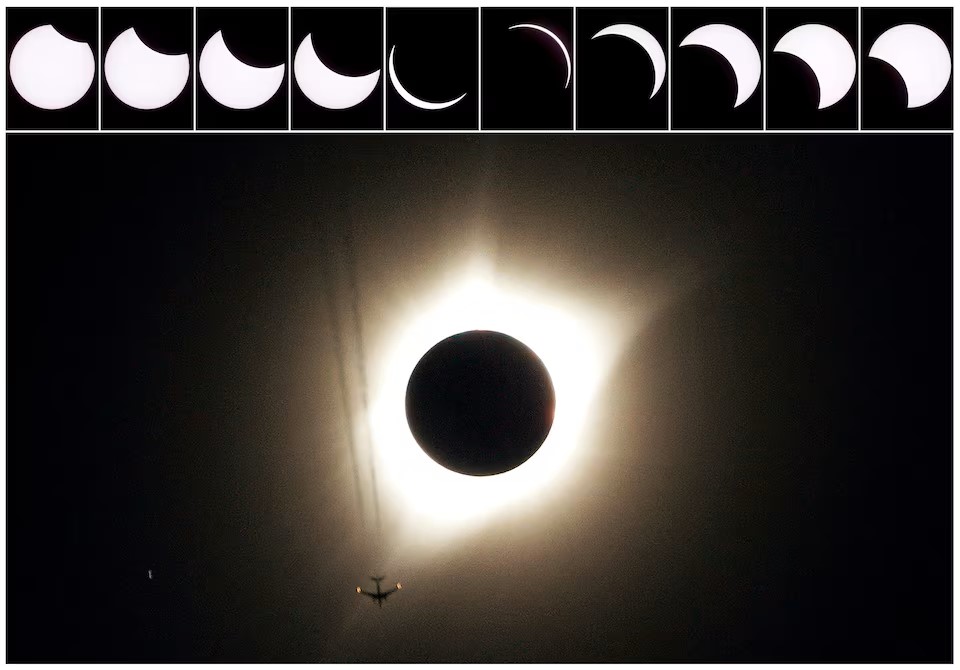Total solar eclipse 2024: When is it and what to expect?

WASHINGTON, April 8 (Reuters) - The moon will blot out the sun for millions of people in North America along a path crossing from Mexico into the United States and then Canada in a total solar eclipse occurring on Monday, April 8.
Here is an explanation of the solar eclipse, where it will be visible and what to expect.
WHAT IS A TOTAL SOLAR ECLIPSE?
In a total solar eclipse, the moon passes between the sun and Earth, entirely covering the face of the sun along a small path of our planet's surface. This is called the "path of totality." The daytime sky turns dark, akin to dusk or dawn, and nocturnal animals have been known to wake up, confused into believing night has arrived.
In places along the path of totality, people will be able to view the sun's corona - the star's outer atmosphere - that typically is not visible because of solar brightness. People observing from outside the path of totality will see a partial eclipse in which the moon obscures most of the sun's face but not all of it.
Of course, a cloudy day could spoil the view. After this one, the next total solar eclipse viewable from the contiguous United States will not occur until 2044.
WHERE WILL IT BE VISIBLE?
, opens new tab, the April 8 eclipse will begin over the South Pacific, with its path reaching Mexico's Pacific coast at around 11:07 a.m. Pacific Time before entering the United States in Texas.
Its path then takes it through Oklahoma, Arkansas, Missouri, a tiny piece of Tennessee, Illinois, Kentucky, Indiana, Ohio, a tiny piece of Michigan, Pennsylvania, New York, Vermont, New Hampshire and Maine.
The path then enters Canada in Ontario and journeys through Quebec, New Brunswick, Prince Edward Island and Cape Breton, exiting continental North America on the Atlantic coast of Newfoundland, Canada, at 5:16 p.m. Newfoundland Time. A partial eclipse is due to be visible for people in all 48 contiguous U.S. states.
WHERE ARE SOME OF THE BEST PLACES TO SEE THE ECLIPSE?
Some major cities and their metropolitan areas lay within or near the path of totality. Some of these include: Mazatlan and Torreon in Mexico; San Antonio, Austin, Waco, Fort Worth and Dallas in Texas; Little Rock in Arkansas; St. Louis in Missouri; Louisville in Kentucky; Indianapolis in Indiana; Dayton, Columbus, Toledo and Cleveland in Ohio; Detroit in Michigan; Erie in Pennsylvania; Buffalo, Rochester and Syracuse in New York; and Hamilton, Toronto and Montreal in Canada.
HOW WIDE IS THE PATH OF TOTALITY?
On Aug. 21, 2017, millions of people witnessed a total solar eclipse whose path crossed the contiguous United States. The path of totality for the April 8 eclipse will be wider than the one in 2017 because the moon was a little bit farther from Earth during that one. According to NASA, the path in 2017 ranged from about 62-71 miles (100-114 km) wide while this one will range from about 108-122 miles (174-196 km) wide, meaning it will cover more ground. This year's eclipse path also is set to pass over more densely populated areas than the one in 2017.
WHAT CAN YOU EXPECT TO SEE DURING THE ECLIPSE?
A total solar eclipse unfolds in several distinct stages.
It starts with a partial eclipse phase as the moon begins to pass between Earth and the sun, partially blocking it and leaving the sun looking like it has a crescent shape.
In the subsequent Baily's Beads phase, points of light from the sun shine around the moon's edges because of the irregular lunar topography, producing small beads of light.
n the diamond ring phase, a single bright spot appears along the lunar edge even as the sun's atmosphere leaves a ring of light around the moon. The effect resembles the appearance of a diamond ring. This phenomenon precedes totality.
After totality, the other phases repeat as the moon keeps moving along its path until the eclipse ends.
HOW DOES THIS DIFFER FROM AN ANNULAR SOLAR ECLIPSE?
On Oct. 14, 2023, people along a path stretching from the U.S. Pacific Northwest, through Mexico, Central America, Colombia and Brazil witnessed an annular solar eclipse, a slightly different event. An annular solar eclipse occurs when the moon passes between the sun and Earth when the moon is at or near its farthest point from our planet. Thus, it does not completely cover the face of the sun, leaving what looks like a "ring of fire" in the sky.
More Info [Via]








